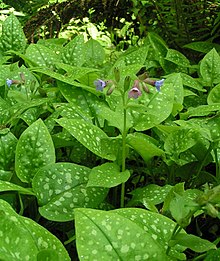(Pulmonaria officinalis)
The lungworts are the genus Pulmonaria of flowering plants in the family Boraginaceae, native to Europe and western Asia, with one species (P. mollissima) east to central Asia. According to various estimates the taxonomy of this genus is very confusing, because there may be between 10 and 18 Pulmonaria species found in the wild.
The scientific name Pulmonaria is derived from Latin pulmo (the lung),did you know that 'wort' ending simply means plant? Other examples are Mugwort and Soapwort.
The spotted oval leaves of P. officinalis were thought to symbolize diseased, ulcerated lungs, and so were used to treat pulmonary infections, in the times of sympathetic magic.
did you know that 'wort' ending simply means plant? Other examples are Mugwort and Soapwort.
 |
| Pulmonaria officinalis |
 |
| Flowers of Pulmonaria officinalis |
 |
| Flowers of Pulmonaria officinalis the colour of the flower in bud is often pink, which then changes as the flower matures. |
Properties: emollient, demulcent, mucilage, expectorant, astringent, vulnerary, and tonic.
What it affects:liver, intestines, lungs and bronchial's.
Preparation and amount:
Infusion: steep 5-15 min. and drink 6 oz at a time.
Tincture: drink 15-30 drops 3 time a day.
Fluid extract: drink 1/2-1 tsp. 3 time a day.
Powder: drink 10 #0 capsules (60 grains) 3 times a day.
Purposes:
Internally, lungwort tea is used primarily for the respiratory system, especially when there is bleeding of the lungs. It is also reliable for asthma, coughs colds and bronchial and catarrhal problems.It is also counteract inflammation and will help heal tissues. it is also used for hemorrhoids, diarrhea, and hoarseness. It is also mildly diuretic.
Externally, lungwort tea is used for all kinds of wounds and swellings. It is best for washing for the infected sores.
Plant Description:
*Depending on variety, Lungwort ranges in height from 15 - 40cm with a spread of 45 - 60cm.
*It has five-petaled flowers that extend in clusters as short bells from the green, hairy bracts and stems.
*Lungwort has creeping rhizome's that can help it to spread.
*Their leaves, which are pointed ovals and in some cases thin (similar to the leaves of plantain), range in colour from plain green, through a whole host of greens with spots, blotches and smudges of white, cream and silvery grey.
*The colours of the flowers range from pure white through to shades of red, pink, violet and a full range of blues
*Depending on variety, Lungwort ranges in height from 15 - 40cm with a spread of 45 - 60cm.
*It has five-petaled flowers that extend in clusters as short bells from the green, hairy bracts and stems.
*Lungwort has creeping rhizome's that can help it to spread.
*Their leaves, which are pointed ovals and in some cases thin (similar to the leaves of plantain), range in colour from plain green, through a whole host of greens with spots, blotches and smudges of white, cream and silvery grey.
*The colours of the flowers range from pure white through to shades of red, pink, violet and a full range of blues
No comments:
Post a Comment